|
Seeing that the Twingo got quite a workout
over the whirlwind four-day weekend, I decided to give it a well-needed
rest. Likewise, I was also feeling the effects of my parents’
visit, and decided that I would have a little look around l’environs
d'Eygalières. After all, I hadn’t really explored
the town much at all. Plus, the weather outlook was grim, and
I figured it might be prudent to stay close to home in case it
decided to rain again. All of this of course is rationalizing
the fact that I wanted to watch the two Rugby World Cup semi-finals,
Australia-New Zealand and England-France.
|
|
|
|
As I had mentioned, I relocated from
Mollégès to a new chambre d’hôte
in Eygalières, the next village to the south. Although
Mme. Fabre was very hospitable and her rooms immaculate,
I made the move for a number of reasons. For one, my new
room is cheaper at €38 compared to €45 in Mollégès.
It doesn’t sound like much, but it amounts to a savings
of $700 over the duration of mon séjour.
Second, the new room is a fair bit larger with a good size
bed and a makeshift desk. And lastly, Eygalières
is just a really pretty town.
The room itself has an exterior entrance
(a must for such a long stay) into a garden setting full
of olive trees and a pool which must be nice in the summer.
The pool house has a fridge which I've been given permission
to use as I see fit. The room is located just around the
corner form the main downtown area. There’s a pretty good
bar and café there that serves Leffe à
pression (on tap). Leffe is a nice deep golden Belgian
beer and at 6.6%, it doesn’t take more than a few to start
feeling the effects.
My new propriétaires
are M. and Mme. Divol, a very nice couple. He’s a retired
school teacher and took an immediate interest in my French
workbook, which I unfortunately hadn’t touched since I’ve
been in France. On my first morning there, the Divols invited
me for breakfast to find out what I was all about. They
peppered me with questions about where I was from and why
I was in France. Neither speak any English but they talk
slowly and use simple words when addressing me, so we get
on just fine. Though they’ve never been to the US, they
have a son in Cleveland and know quite a bit about the States.
They have an old English sheepdog named OM after Olympique
de Marseille who were just eliminated from the Champions
League by Real Madrid. That’s about all I know about them
since our paths don’t seem to cross much. |
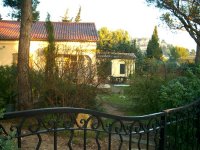
The Divols' house
with the old town in the backround.
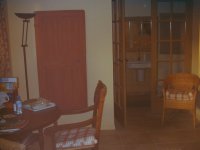
Ma nouvelle chambre.
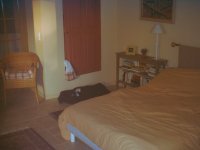
Encore ma nouvelle
chambre.
|
|
|
| 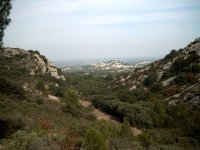
A view back towards
Eygalières as the GR6 winds up through the Alpilles.
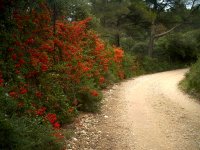
The little color
that remains this time of year along the GR6.
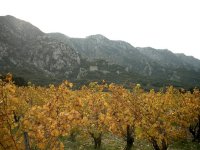
Château Romainin
surrounded by vineyards.
|
As I said, I hadn’t really looked around Eygalières
at all, so I decided to go for a hike around the town. I
pulled out my trusty topographic map and started planning
a circuit which would take me completely around the village
and its surroundings. The French topo maps are excellent.
They include every road, paved or otherwise, as well as
footpaths. As it so happens when I step out my door, I’m
right on the GR6, one of the country’s Grand Randonnée
long-distance walking trails.
I decided to follow the GR6 up through a pass in the Alpilles
to the south and swing around westward towards the ruins
of the Château Romanin. I can’t find any background
on the château itself, but there isn’t much left of
it and there was no way to access the remnants. The ruins
sit atop a hill that oversees the vineyards of the Domaine
Romanin, a fairly large winery situated on the outskirts
of St. Rémy de Provence. The grounds also contain
a “wine walk” in which tourists are invited to stroll along
a path through the vines and read signs that explain the
history of wine making in the area. Not surprisingly, the
path ends at the cave, sort of the Domaine Romanin’s
outlet for wine tasting and purchasing. None of this is
open in the winter though.
My chosen path swung back around
through some almond, olive, and various fruit groves. Provence
is dotted with charming stone farmhouses called mas.
While some are small and quaint, many are very large and
have rooms for rent. Typically, the mas has a name
(Mas de Romanin, Mas du Rouge, Mas St. Jean, etc.) and consists
of several stone buildings surrounded by gardens and orchards.
Farmers sell their goods at markets in the surrounding villages
where there seems to be at least one market a day. The larger
towns have Saturday marchés, but many of
the smaller villages have theirs on weekdays. |
|
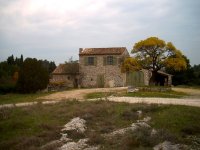
A fine example of
a mas just outside Eygalières.
|
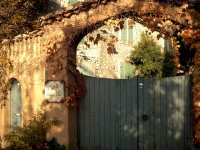
Entrance to Mas
Bayard.
| 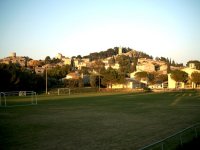
Coming back into
the village perché of Eygalières .
|
|
|
|
Perched atop a small limestone hill, Eygalières
provides a spectacular view of the Alpilles extending to
the Rhône. Although a settlement in Neolithic times,
it was the Romans who brought it prominence. In the 6th
century, Roman engineers began building an aqueduct to transport
the water gushing from the natural spring at this site to
supply the burgeoning city of Arles some 20 km away. This
prompted the Romans to name the area Aquileria,
collector of water. The name passed down into Provençal
as Eigaliero and finally into its current form.
As so many other medieval villages in this part of the
country, the inhabitants huddled within town walls under
the protection of a keep. Hardly anything remains of the
castle in Eygalières any more, and in fact not much
of the old town remains at all. There are a number of old
houses, which have been restored inside for habitation but
retain the original façades, as well as one of the
city gates called the Porte de l’Auro. The 12th century
castle at the crest of the hill is in ruins as is the old
chapel and church. A tower to the west of the summit is
all that remains of a windmill, and a similar tower to the
right was built in 1660 by Henri de Guise when he acquired
the town.
On the road to Orgon and near the
spring that gave Eygalières its name, the Romans
built a small temple to Sylvanus, the god of fields, woods
and flocks. On the same site in the 12th century, a simple
but charming Romanesque chapel called Chapelle Saint-Sixte
was built. It has become the symbol of the town and can
be seen in almost any tourist book or postcard stand throughout
Provence. It’s no longer in use since the last friar died
in 1855, except on Easter Sunday when the citizens of Eygalières
dress in costume and have a procession to attend mass given
in the chapel.
By the way, Australia edged New Zealand in a thriller and
England punished France to meet one another in the final
next weekend.
|
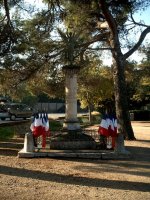
The town war memorial
decked out for Armistice Day..
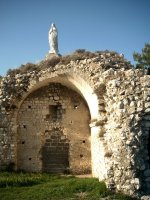
Ruins of a chapel
in the old town.
|
|
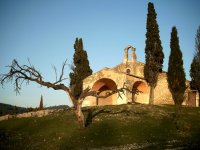
The 12th century Chapelle
Saint-Sixte build near the spring that gave the town its name. |
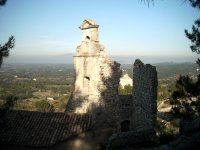
A view toward Cavaillon
and of a ruined church that now houses the town museum. |
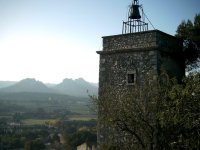
A reconstructed bell
tower with a traditional wrought iron bellfry of Provence. |
|
|

